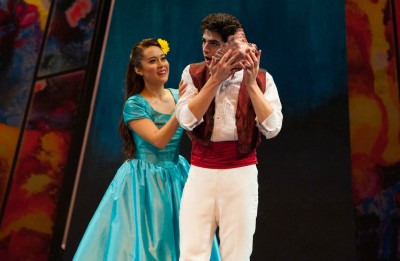Reprising a partnership of creative success, The Washington Ballet and Imagination Stage’s latest collaboration, “The Little Mermaid,” is a lush re-imagining of a classic tale about aspirations, finding beauty in loss and embracing tolerance.
“It’s about anything and everything we aspire to as human beings, but don’t necessarily achieve,” said Janet Stanford, Imagination Stage’s artistic director. “The value in that is that we’re always reaching. And that, in itself, is a good thing.”
Associate Artistic Director Kathryn Chase Bryer directs the 90-minute production, ideal for children, ages 5 and older. From The Washington Ballet, Artistic Director Septime Webre and David Palmer choreographed the dance.
![Merfather forbidsPearl and her sisters to interact with humans. [Emily Zickler, Afua Busia, Justine Icy Moral, and Todd Scofield]](https://www.culturespotmc.com/wp-content/uploads/sites/www.culturespotmc.com/images/2016/07/4-400x302.jpg)
Stanford came up with Imagination Stage’s original adaptation of the Hans Christian Anderson tale about a young mermaid who is willing to give up her beautiful voice—even her life—if it gives her a shot at being with the one she loves.
This also is a chance for the Bethesda-based theater company to showcase what it has become known for: producing quality shows for kids that somehow manage to transcend the boundaries of age, something worthy of acclaim simply because it is good theater regardless of whether you are 5 or 55.
Imagination Stage has earned numerous Helen Hayes Awards and nominations, including several in 2013 for its production of “The Lion, The Witch and The Wardrobe,” the first time the theater collaborated with Washington Ballet. Ever since, the two arts organizations have wanted to work together on another production. Hoping to parlay the success of their first award-winning collaboration, the two creative powerhouses have joined forces again for “The Little Mermaid.”
Dance and theater do not clash. Regardless of an artist’s preferred mode of expression, storytelling is a common theme. “There’s a synergy in storytelling,” Webre said “We are the more than the sum of our parts.”
The challenge was staying true to the charm and bitter-sweetness of the original in a way that’s accessible to a generation of children—and maybe even some of the parents—who are more familiar with Disney’s animated film version.
There are clear points of access in the original tale. After all, moms, dads and kids in the audience are watching the story of a family of mer-people, how the dynamic between these sisters and their father play out in an underwater world. “So we, in the audience, think, ‘Well, I’m a sister, I know what that feels like or a child who says, ‘Yeah, I feel like that about my family, sometimes,’” Bryer said.

Unlike “The Lion, The Witch & The Wardrobe,” “The Little Mermaid” incorporates even more dancing into the production.
A unique aspect of the show is that dual characters perform on stage—the actor with lines and dancers who express the character’s inner thoughts and lives. It’s a convention introduced early on so that the audience understands that the actor and dancers are one and the same.
“Among the most adventuresome moments, choreographically, are the moments where we seek to describe mermaids swimming in the ocean and seahorses swimming in the ocean,” Webre said. “We had a lot of fun creating movement in swimming—that includes dancers being held aloft in the water and really ingenious partnering.”
Classical ballet already lends itself well to classical stories that are archetypal, Webre said. Imagine the possibilities that open up when the lead character in the narrative trades her voice for a pair of legs.
Webre said they set out to build an entire vocabulary of movement.
The set, costuming and the original score provide the right atmospherics. The play is set in the mid-18th century; the actors on “land” don 18th century Danish court apparel. For the world of the mer-people, the waves of silk and creative puppetry create the life under the sea, whereas actors have stylized “water suits” that make their legs look like fins.
But then there are more complex themes like going after the unattainable and embracing those who are not like you. Mer-people and humans don’t quite get along.
The ending presented the biggest challenge and, perhaps, resulted in the greatest creative reward. We will not give away the ending here, but it is worth mentioning that it was everyone’s favorite part of the show. Webre described it as an exquisite aerial pas de deux.
“What I attempted to do,” Stanford said, “was find an ending that is triumphant and cognitive, without completely changing the story and going to the ‘happily ever after’ place that Disney goes to with their version.”
Should parents fear not going to that “happily ever after” place? Not when they’re in the safety of the theater.
“It shows the child that we can be resilient; we can get through difficult times in our lives,” Stanford said. “That we can be survivors and heroes, just like the great characters in literature.”
“The Little Mermaid” is on the Imagination Stage, 4908 Auburn Ave., Bethesda, through Aug. 14. Visit www.imaginationstage.org.